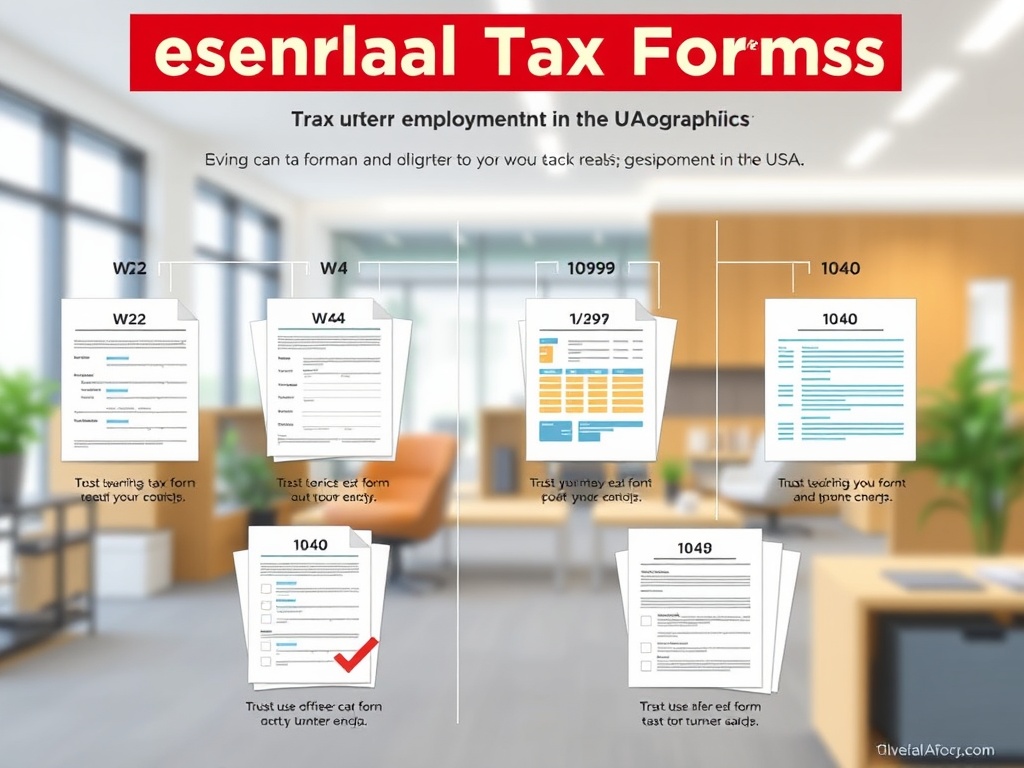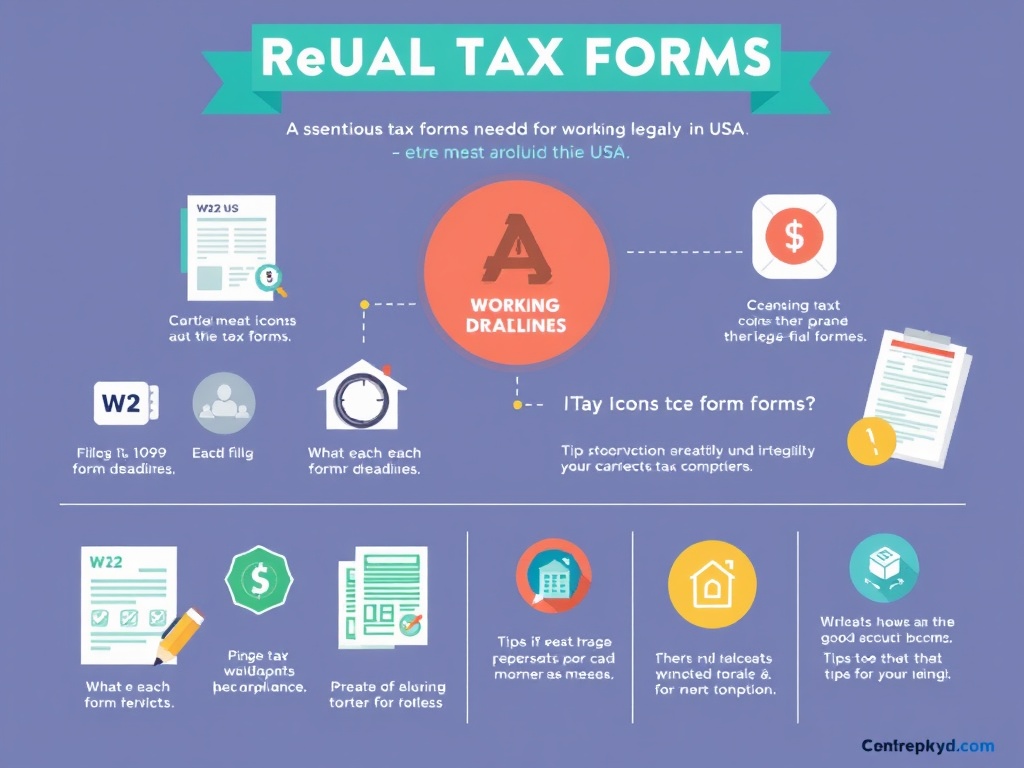Understanding the Essential Tax Forms for Employment in the USA

Every employee in the United States is required to file their taxes annually, and a key part of this process involves understanding the various tax forms that are integral to employment. These forms not only determine how much tax you owe but also ensure that you are compliant with legal requirements. Whether you’re a seasoned employee or new to the workforce, grasping these forms is essential for your financial well-being.
While there are many tax forms, a few stand out as particularly crucial for employees. Familiarizing yourself with these forms will help you navigate your tax obligations effectively. Below is a list of the most important tax forms you should be aware of:
- W-2 Form: This form is issued by your employer and reports your annual wages and the amount of taxes withheld from your paycheck. It is essential for filing your income tax return.
- W-4 Form: This is the form you fill out when you start a new job. It informs your employer about your tax withholding preferences, including the number of dependents you claim.
- 1099 Form: If you are an independent contractor or freelancer, you’ll receive this form instead of a W-2. It details your earnings and is essential for reporting your income.
- 1040 Form: This is the standard individual income tax return form used to report your income and calculate your taxes owed to the IRS.
Filing your taxes can seem daunting, but understanding the process can make it much more manageable. Here’s a simplified overview of what you can expect:
- Gather Necessary Documents: Collect all relevant tax forms, including W-2s, 1099s, and any other income documentation.
- Choose a Filing Method: Decide whether to file your taxes online using tax software, hire a tax professional, or file by mail.
- Fill Out Your Forms: Accurately complete the relevant forms, ensuring all information is correct and complete.
- Submit Your Tax Return: Send your completed tax return to the IRS by the deadline, which is typically April 15th.
- Pay Any Taxes Owed: If you owe taxes, ensure you make the payment by the due date to avoid penalties.
Navigating the Complexities of IRS Form 1040: A Guide for Workers

The IRS Form 1040 is often referred to as the backbone of the tax filing process for individual taxpayers in the United States. As a worker, understanding how to accurately complete this form is crucial not only for compliance but also for maximizing potential refunds. This form allows you to report your total income, claim deductions, and ultimately determine your tax liability. With tax laws continually evolving, being well-informed can save you both time and money.
To help demystify the filing process, let’s break down the essential sections of Form 1040. Understanding these areas will help you gather the necessary information and prepare your tax return efficiently.
- Personal Information: This section requires your name, address, and Social Security Number. Accurate details are important to avoid processing errors.
- Income Reporting: Here, you will provide details of your income sources, including wages from W-2 forms and earnings from 1099 forms.
- Deductions and Credits: You can choose between standard and itemized deductions. Understanding what deductions you qualify for can significantly affect your taxable income.
- Refund or Amount Due: This section will calculate whether you owe taxes or are entitled to a refund. Pay careful attention to this as it affects your financial planning.
To ensure a smooth filing process, consider the following tips when working on your Form 1040:
- Gather Documentation: Collect all relevant documents, including W-2s, 1099s, and any receipts for deductible expenses.
- Use Reliable Resources: Make use of IRS instructions for Form 1040 or reputable tax software to guide you through the process.
- Double-Check Entries: Mistakes can lead to delays or penalties, so review your entries carefully before submission.
- File Early: Don’t wait until the last minute to file. Early submission can help you avoid common pitfalls and give you time to address any issues that arise.
Tax Responsibilities for Non-Resident Aliens: What You Must Know
For non-resident aliens working in the United States, navigating the tax landscape can be particularly complex. Unlike U.S. citizens or resident aliens, non-resident aliens are subject to specific tax rules and regulations that shape their filing responsibilities. Recognizing these obligations is essential for compliance and can significantly impact financial outcomes. Non-resident aliens must understand the distinction between income types and the relevant tax forms required for accurate reporting.
Non-resident aliens typically use Form 1040-NR to report their income and calculate any taxes owed. This form is tailored specifically for those who do not meet the criteria for residency and ensures that they adhere to U.S. tax laws. Additionally, non-residents may also be required to submit Form 8843 to explain their presence in the U.S. and affirm their non-resident status. The importance of these forms cannot be overstated, as failure to file correctly can lead to penalties or complications in future visa applications.
It’s crucial for non-resident aliens to keep meticulous records of their income sources, tax withheld, and any applicable deductions. Deductions for non-resident aliens can be limited compared to those for residents, focusing primarily on certain types of income such as wages or salaries earned in the U.S.
Non-resident aliens should also explore the possibility of tax treaties between their home country and the United States. These treaties can provide significant benefits, such as exemptions or reduced rates on certain types of income. Understanding the provisions of these treaties is vital, as they can influence the overall tax liability and provide potential savings. It is advisable to consult the IRS website or a tax professional to determine the applicability of any treaties and how they can be leveraged.
In summary, non-resident aliens in the U.S. have distinct tax responsibilities that require careful attention to detail. Being informed about the correct forms, understanding potential deductions, and exploring tax treaty benefits are essential steps in ensuring compliance and optimizing tax outcomes. As tax laws continue to evolve, staying updated on changes and seeking professional advice when necessary can aid in navigating this complex landscape effectively.
Maximizing Your Deductions: Essential Tax Forms for Self-Employed Individuals
Self-employed individuals often face a unique tax filing landscape that differs significantly from traditional employees. Understanding the necessary tax forms and leveraging available deductions can lead to substantial savings and improved financial health. As a self-employed worker, it’s crucial to familiarize yourself with the tax forms that will enable you to maximize deductions and minimize your tax liability.
When it comes to filing taxes, self-employed individuals must utilize a specific set of forms tailored to their unique situation. Below is a concise list of essential forms that you should be aware of:
- Schedule C (Form 1040): This form is used to report income or loss from a business you operated or a profession you practiced as a sole proprietor. It allows you to detail your business income and expenses, setting the stage for potential deductions.
- Form 1040: This is the standard individual tax return form. Self-employed individuals will complete this form in conjunction with Schedule C to report overall income.
- Schedule SE (Form 1040): This form is vital for calculating self-employment tax, which encompasses both Social Security and Medicare taxes for self-employed individuals.
- Form 4562: If you have business assets, you’ll need this form to claim depreciation and Section 179 deductions, which can significantly reduce your taxable income.
To optimize your tax situation, it’s essential to identify and document all possible deductions. Here are some strategies to consider:
- Track Your Expenses: Maintain accurate records of all business-related expenses, including materials, utilities, and travel costs. Keeping receipts and using accounting software can simplify this process.
- Home Office Deduction: If you use part of your home exclusively for business, you may qualify for a home office deduction. Calculate the percentage of your home used for business to determine the deductible amount.
- Health Insurance Premiums: Self-employed individuals can deduct health insurance premiums for themselves and their families, reducing taxable income significantly.
- Retirement Contributions: Consider contributing to a retirement plan designed for self-employed individuals, such as a SEP IRA or Solo 401(k). Contributions can be deducted, providing immediate tax benefits while saving for the future.
Accurate record keeping is vital for self-employed individuals, not only for maximizing deductions but also for ensuring compliance with tax regulations. Failure to maintain clear records can lead to missed deductions and potential issues during an audit. Investing in accounting software or hiring a professional can help streamline this process, allowing you to focus on your business while ensuring your tax obligations are met.
The Impact of Employment Status on Your Tax Forms: Employee vs. Contractor
When it comes to tax obligations in the United States, your employment status plays a crucial role in determining which tax forms you need to complete and how you report your income. Understanding the differences between being an employee and a contractor is essential for compliance and can significantly affect your tax liability. Each status comes with its own set of requirements and tax implications that can influence your financial planning.
Employees are typically those who work for an organization under a formal agreement, receiving regular wages and benefits. In contrast, independent contractors operate as self-employed individuals, providing services to businesses without a long-term employment relationship. This distinction is not merely semantic; it affects how taxes are withheld and reported. For employees, employers withhold income taxes, Social Security, and Medicare taxes. On the other hand, contractors are responsible for managing their tax payments, including self-employment taxes, which encompass both Social Security and Medicare contributions.
Understanding the specific tax forms associated with each employment status is critical for accurate filing. Employees receive a W-2 form at the end of the year, detailing their earnings and the taxes withheld by their employer. This form simplifies the process for employees, as much of the tax calculation is handled by the employer. Conversely, independent contractors receive a 1099 form, which reports their earnings but does not withhold any taxes. This means contractors must keep meticulous records of income and expenses to accurately report on their Schedule C and calculate their tax liabilities on Form 1040.
In addition to these forms, the responsibilities associated with filing taxes differ significantly. Employees generally have fewer responsibilities, as their employer manages tax withholdings. However, contractors must not only file their taxes but also pay estimated taxes quarterly, which can add complexity to their financial planning.
| Aspect | Employee | Independent Contractor |
|---|---|---|
| Tax Form | W-2 | 1099 |
| Tax Withholding | Handled by Employer | Self-Managed |
| Tax Filing | Annual Return (Form 1040) | Annual Return + Schedule C |
| Estimated Taxes | No | Yes |
Furthermore, the ability to claim deductions varies between employees and contractors. While employees may have limited options for deductions, contractors can often deduct a broader range of business expenses. This can include everything from office supplies to travel expenses, which can significantly reduce taxable income if documented correctly.
In summary, understanding your employment status is essential for navigating the complexities of tax forms and obligations in the U.S. Whether you are an employee or an independent contractor, knowing your specific requirements and responsibilities can lead to better financial outcomes and ensure compliance with tax regulations.
Filing Taxes as an Immigrant: Key Forms and Deadlines You Shouldn’t Miss
Navigating the tax system in the United States can be particularly challenging for immigrants. As a newcomer, understanding your tax obligations is crucial, not only for compliance but also for avoiding potential penalties. Immigrants must be aware that their residency status significantly impacts their tax filing requirements. Depending on whether you are a resident alien or a non-resident alien, the forms you need to complete and the deadlines you must meet may vary. Grasping these distinctions is essential for ensuring that you meet all necessary requirements.
When it comes to filing taxes, immigrants often encounter a unique set of forms that cater to their specific situations. The most prominent form you will likely encounter is the Form 1040 for resident aliens, which allows you to report worldwide income and claim applicable deductions and credits. Conversely, non-resident aliens primarily use Form 1040-NR. This form is designed to report income earned in the U.S. and has specific rules regarding deductions. For those who qualify, Form 8843 is also essential, particularly for individuals who wish to explain their presence in the U.S. and assert their non-resident status.
Additionally, it’s important to acknowledge that some immigrants may be eligible for tax treaties between their home country and the U.S. These treaties can often provide significant tax benefits, such as reduced rates on certain types of income or exemptions. Consulting the IRS website or a tax professional familiar with international tax law can help you navigate these complexities effectively.
Timeliness is a critical aspect of the tax filing process. For most immigrants, the tax season begins on January 1st and ends on April 15th, which is the standard deadline for filing your tax return. However, if you are a non-resident alien, you may have different deadlines based on your specific circumstances. Understanding these deadlines is vital to avoid penalties.
In some instances, you may qualify for an extension, allowing you to file your tax return later. However, it is important to note that an extension to file does not grant an extension to pay any taxes owed. Therefore, any anticipated tax payments should be submitted by the original deadline to mitigate interest and penalties. Keeping track of these dates will not only ensure compliance but also provide peace of mind as you manage your tax obligations.
| Form Type | Applicable For | Filing Deadline |
|---|---|---|
| Form 1040 | Resident Aliens | April 15 |
| Form 1040-NR | Non-Resident Aliens | April 15 |
| Form 8843 | Non-Resident Aliens | April 15 |
Understanding Withholding Tax: Forms That Affect Your Take-Home Pay
When you receive your paycheck, the amount you take home is often less than your gross earnings due to various deductions, including federal and state taxes. Understanding withholding tax is vital for employees in the U.S., as it directly affects your disposable income. It is essential to grasp how these taxes are calculated and what forms are involved in ensuring you comply with tax obligations while maximizing your take-home pay.
Withholding tax refers to the portion of your wages that your employer deducts for federal, state, and sometimes local taxes. The amount withheld depends on several factors, including your income level, filing status, and the information you provide on your W-4 form. Below is a brief overview of the key forms that play a significant role in determining your withholding tax:
- W-4 Form: This is the primary form you fill out upon starting a new job. It guides your employer on how much federal income tax to withhold from your paycheck based on your personal situation.
- W-2 Form: At the end of the tax year, your employer provides you with this form, summarizing your total earnings and the amount withheld for taxes, which you will need for filing your tax return.
- State Tax Forms: Depending on your state, you may also need to fill out additional forms that determine your state tax withholding.
Making informed decisions regarding your withholding can have a profound impact on your financial situation. Here are some key points to consider:
- Adjusting Your W-4: If you find that too little or too much is being withheld, you can submit a new W-4 form to your employer. This can help you achieve a balance between receiving a larger paycheck versus a potential tax refund or balance due at tax time.
- Understanding Tax Brackets: The U.S. uses a progressive tax system, meaning that your income is taxed at different rates. Knowing which bracket you fall into can help you predict your tax obligations more accurately.
- Planning for Deductions: If you anticipate claiming significant deductions, you may want to adjust your withholding to keep more money in your paycheck throughout the year.
| Form | Purpose | Key Information Required |
|---|---|---|
| W-4 | Determines federal income tax withholding | Filing status, number of dependents, additional withholding |
| W-2 | Reports annual wages and taxes withheld | Total earnings, federal/state taxes withheld |
| State Tax Forms | Determines state income tax withholding | State-specific information, exemptions |
By educating yourself about withholding taxes and the forms that influence them, you can better manage your finances and ensure that you are not overpaying or underpaying your taxes. This knowledge empowers you to make informed decisions that directly affect your take-home pay, allowing you to align your financial goals with your tax responsibilities.



